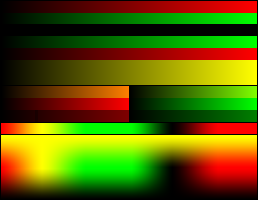RG color models: Difference between revisions
Added {{No footnotes}} tag (TW) |
self link removed Tags: Visual edit Mobile edit Mobile web edit |
||
| Line 17: | Line 17: | ||
==RG color space== |
==RG color space== |
||
Any color containing a blue color component can't be replicated accurately in the RG color space. There is a similar color space called |
Any color containing a blue color component can't be replicated accurately in the RG color space. There is a similar color space called RGK which also has a black channel. Outside of a few low-cost high-volume applications, such as [[packaging and labelling]], RG and RGK are no longer in use because devices providing larger gamuts such as [[RGB color model|RGB]] and [[CMYK color model|CMYK]] are in widespread use. Until recently, its primary use was in low-cost [[light-emitting diode]] displays, where red and green tended to be far more common than the still nascent [[light-emitting diode#Blue and ultraviolet|blue LED]] technology, though full-color LEDs with blue have become more common in recent years. |
||
[[ColorCode 3-D]], a [[stereoscopy|stereoscopic]] color scheme, uses the RG color space to simulate a broad spectrum of color in one eye; the blue portion of the spectrum transmits a black-and-white (black-and-blue) image to the other eye to give depth perception. |
[[ColorCode 3-D]], a [[stereoscopy|stereoscopic]] color scheme, uses the RG color space to simulate a broad spectrum of color in one eye; the blue portion of the spectrum transmits a black-and-white (black-and-blue) image to the other eye to give depth perception. |
||
Revision as of 20:52, 3 October 2020
This article has multiple issues. Please help improve it or discuss these issues on the talk page. (Learn how and when to remove these messages)
|
The RG or red-green color space is a color space that uses only two colors, red and green. It is an additive format, similar to the RGB color model but without a blue channel. Thus, blue is said to be out of gamut. This format is not in use today, and was only used on two-color Technicolor and other early color processes for films; by comparison with a full spectrum, its poor color reproduction made it undesirable. The system cannot create white naturally, and many colors are distorted.
RG color space
Any color containing a blue color component can't be replicated accurately in the RG color space. There is a similar color space called RGK which also has a black channel. Outside of a few low-cost high-volume applications, such as packaging and labelling, RG and RGK are no longer in use because devices providing larger gamuts such as RGB and CMYK are in widespread use. Until recently, its primary use was in low-cost light-emitting diode displays, where red and green tended to be far more common than the still nascent blue LED technology, though full-color LEDs with blue have become more common in recent years.
ColorCode 3-D, a stereoscopic color scheme, uses the RG color space to simulate a broad spectrum of color in one eye; the blue portion of the spectrum transmits a black-and-white (black-and-blue) image to the other eye to give depth perception.
See also
References
- Even Proportional Color Triangle
- Cinematographic Multiplex Projection, &c. U.S. Patent No. 1,391,029, filed Feb. 20, 1917.
- "Moving Pictures in Color", The New York Times, February 22, 1917, p. 9.
- The First Successful Color Movie", Popular Science, Feb. 1923, p. 59.
- filmmakeriq.com, The History and Science of Color Film: From Isaac Newton to the Coen Brothers





